Perla's Case Study: Ethical Considerations and Evidence-Based Practice
VerifiedAdded on 2021/05/30
|7
|1837
|57
Case Study
AI Summary
This case study examines the ethical considerations for healthcare professionals when treating stroke patients with pressure injuries, using Perla's case as an example. It explores the application of ethical principles such as autonomy, beneficence, nonmaleficence, and justice within the context of patient care. The study provides a summary of evidence-based recommendations for preventing and managing pressure ulcers, including skin care, foot protection, balanced diets, and enhanced movement. It also discusses how healthcare facilities can embed evidence-based practice into their nursing protocols, including posing clinical questions, seeking solutions, evaluating evidence, and integrating patient input. The study emphasizes the importance of virtue ethics, particularly caring ethics, in the management of aging stroke patients, and stresses the need for compassion, patience, and the application of reliable scholarly sources in medical care.
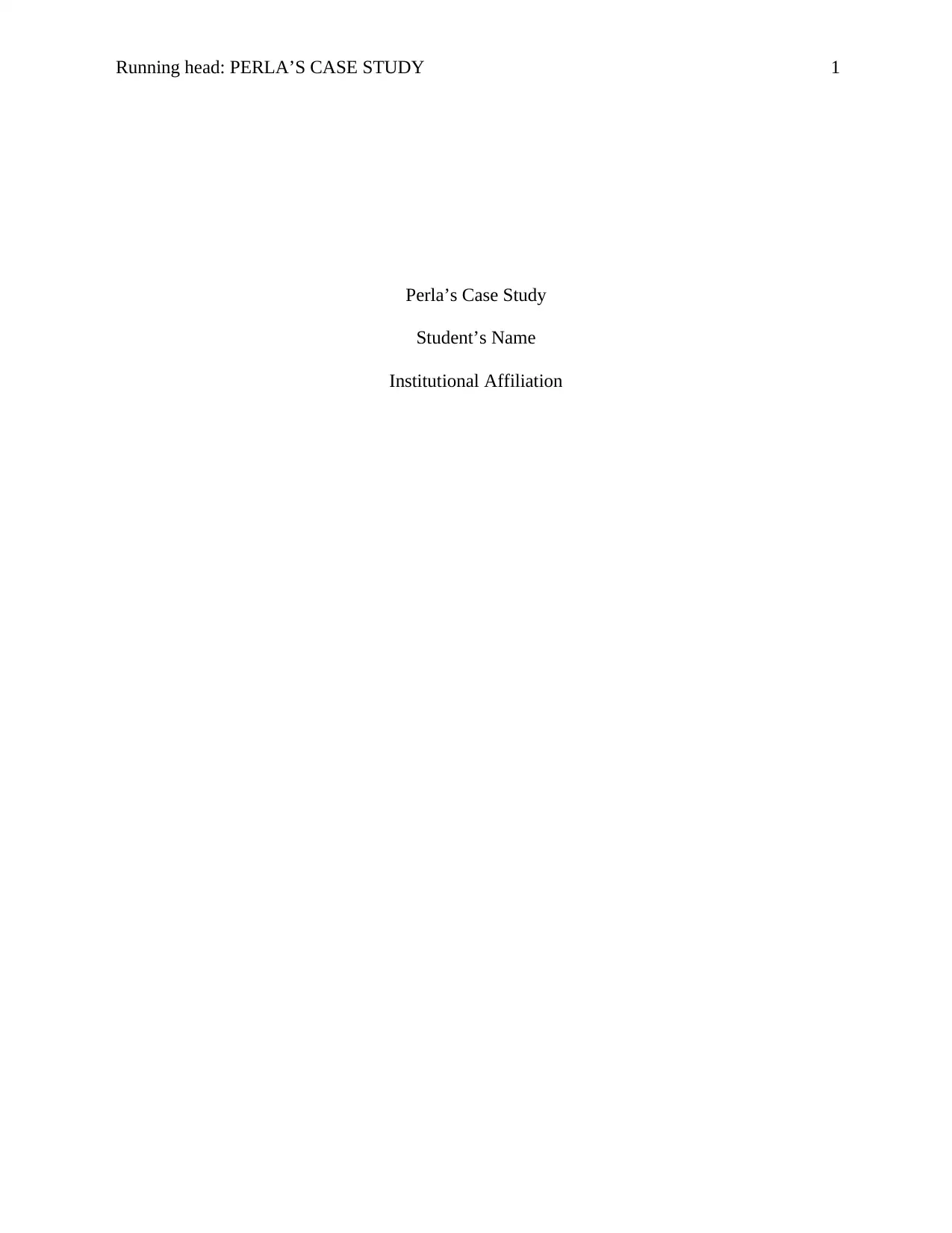
Running head: PERLA’S CASE STUDY 1
Perla’s Case Study
Student’s Name
Institutional Affiliation
Perla’s Case Study
Student’s Name
Institutional Affiliation
Paraphrase This Document
Need a fresh take? Get an instant paraphrase of this document with our AI Paraphraser
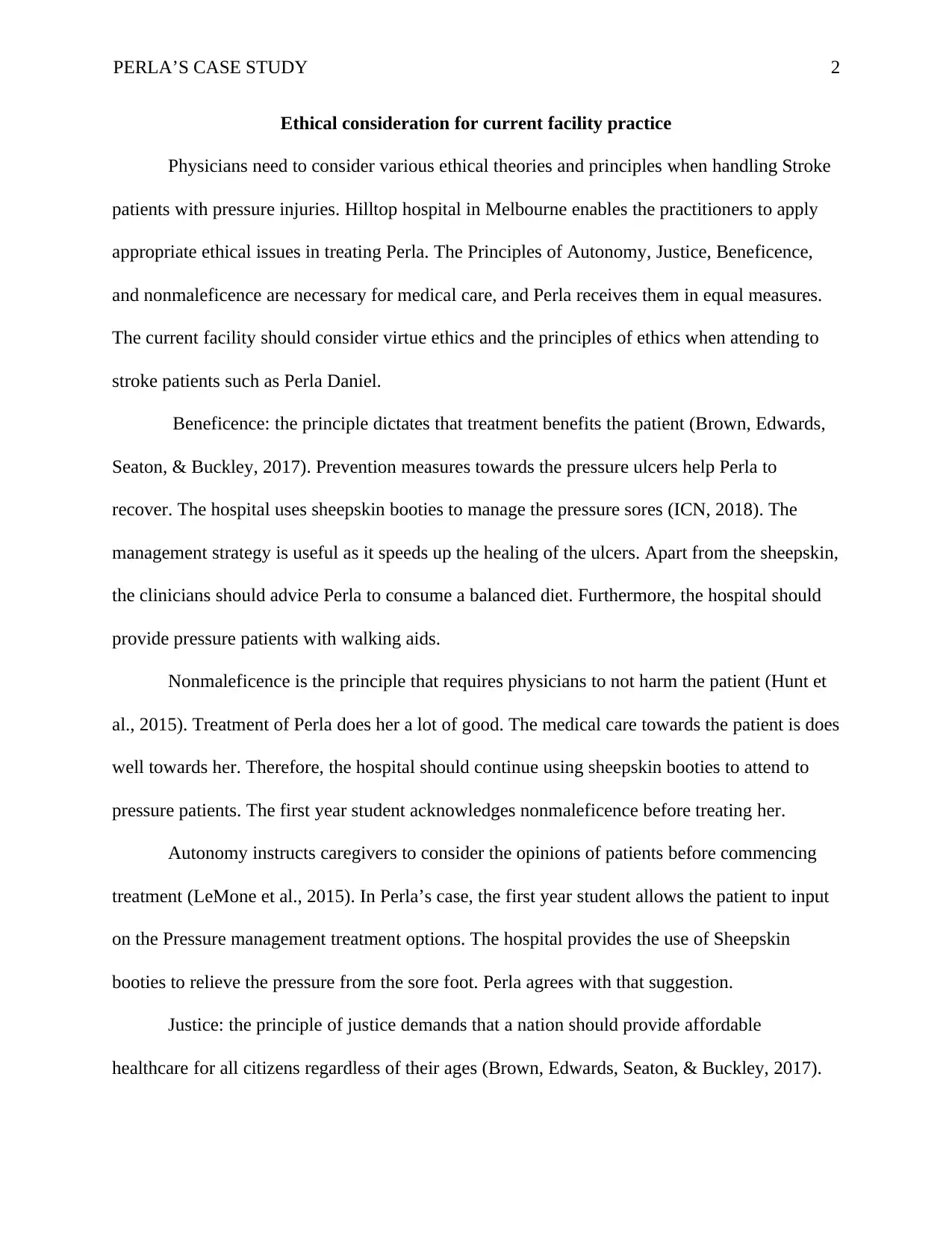
PERLA’S CASE STUDY 2
Ethical consideration for current facility practice
Physicians need to consider various ethical theories and principles when handling Stroke
patients with pressure injuries. Hilltop hospital in Melbourne enables the practitioners to apply
appropriate ethical issues in treating Perla. The Principles of Autonomy, Justice, Beneficence,
and nonmaleficence are necessary for medical care, and Perla receives them in equal measures.
The current facility should consider virtue ethics and the principles of ethics when attending to
stroke patients such as Perla Daniel.
Beneficence: the principle dictates that treatment benefits the patient (Brown, Edwards,
Seaton, & Buckley, 2017). Prevention measures towards the pressure ulcers help Perla to
recover. The hospital uses sheepskin booties to manage the pressure sores (ICN, 2018). The
management strategy is useful as it speeds up the healing of the ulcers. Apart from the sheepskin,
the clinicians should advice Perla to consume a balanced diet. Furthermore, the hospital should
provide pressure patients with walking aids.
Nonmaleficence is the principle that requires physicians to not harm the patient (Hunt et
al., 2015). Treatment of Perla does her a lot of good. The medical care towards the patient is does
well towards her. Therefore, the hospital should continue using sheepskin booties to attend to
pressure patients. The first year student acknowledges nonmaleficence before treating her.
Autonomy instructs caregivers to consider the opinions of patients before commencing
treatment (LeMone et al., 2015). In Perla’s case, the first year student allows the patient to input
on the Pressure management treatment options. The hospital provides the use of Sheepskin
booties to relieve the pressure from the sore foot. Perla agrees with that suggestion.
Justice: the principle of justice demands that a nation should provide affordable
healthcare for all citizens regardless of their ages (Brown, Edwards, Seaton, & Buckley, 2017).
Ethical consideration for current facility practice
Physicians need to consider various ethical theories and principles when handling Stroke
patients with pressure injuries. Hilltop hospital in Melbourne enables the practitioners to apply
appropriate ethical issues in treating Perla. The Principles of Autonomy, Justice, Beneficence,
and nonmaleficence are necessary for medical care, and Perla receives them in equal measures.
The current facility should consider virtue ethics and the principles of ethics when attending to
stroke patients such as Perla Daniel.
Beneficence: the principle dictates that treatment benefits the patient (Brown, Edwards,
Seaton, & Buckley, 2017). Prevention measures towards the pressure ulcers help Perla to
recover. The hospital uses sheepskin booties to manage the pressure sores (ICN, 2018). The
management strategy is useful as it speeds up the healing of the ulcers. Apart from the sheepskin,
the clinicians should advice Perla to consume a balanced diet. Furthermore, the hospital should
provide pressure patients with walking aids.
Nonmaleficence is the principle that requires physicians to not harm the patient (Hunt et
al., 2015). Treatment of Perla does her a lot of good. The medical care towards the patient is does
well towards her. Therefore, the hospital should continue using sheepskin booties to attend to
pressure patients. The first year student acknowledges nonmaleficence before treating her.
Autonomy instructs caregivers to consider the opinions of patients before commencing
treatment (LeMone et al., 2015). In Perla’s case, the first year student allows the patient to input
on the Pressure management treatment options. The hospital provides the use of Sheepskin
booties to relieve the pressure from the sore foot. Perla agrees with that suggestion.
Justice: the principle of justice demands that a nation should provide affordable
healthcare for all citizens regardless of their ages (Brown, Edwards, Seaton, & Buckley, 2017).
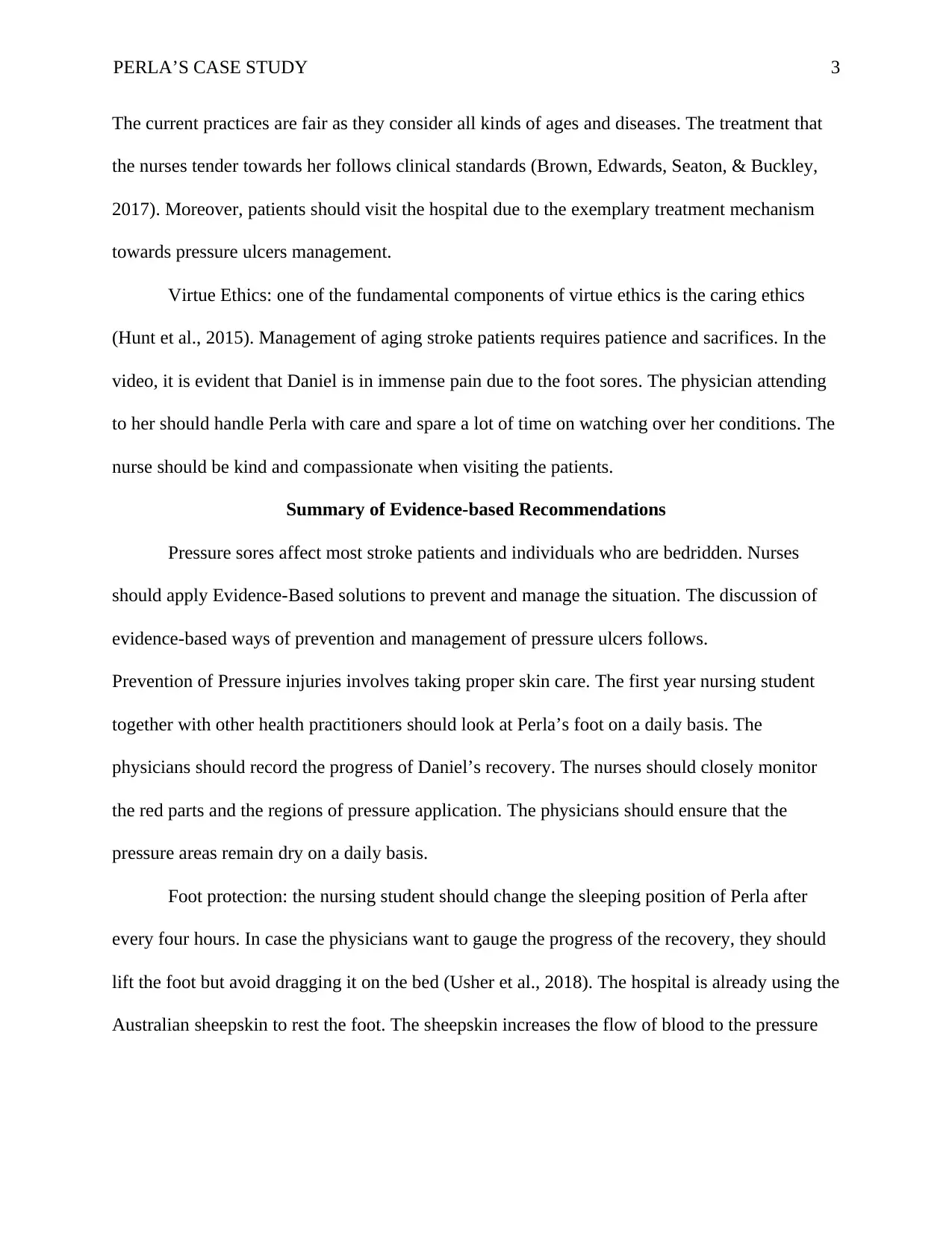
PERLA’S CASE STUDY 3
The current practices are fair as they consider all kinds of ages and diseases. The treatment that
the nurses tender towards her follows clinical standards (Brown, Edwards, Seaton, & Buckley,
2017). Moreover, patients should visit the hospital due to the exemplary treatment mechanism
towards pressure ulcers management.
Virtue Ethics: one of the fundamental components of virtue ethics is the caring ethics
(Hunt et al., 2015). Management of aging stroke patients requires patience and sacrifices. In the
video, it is evident that Daniel is in immense pain due to the foot sores. The physician attending
to her should handle Perla with care and spare a lot of time on watching over her conditions. The
nurse should be kind and compassionate when visiting the patients.
Summary of Evidence-based Recommendations
Pressure sores affect most stroke patients and individuals who are bedridden. Nurses
should apply Evidence-Based solutions to prevent and manage the situation. The discussion of
evidence-based ways of prevention and management of pressure ulcers follows.
Prevention of Pressure injuries involves taking proper skin care. The first year nursing student
together with other health practitioners should look at Perla’s foot on a daily basis. The
physicians should record the progress of Daniel’s recovery. The nurses should closely monitor
the red parts and the regions of pressure application. The physicians should ensure that the
pressure areas remain dry on a daily basis.
Foot protection: the nursing student should change the sleeping position of Perla after
every four hours. In case the physicians want to gauge the progress of the recovery, they should
lift the foot but avoid dragging it on the bed (Usher et al., 2018). The hospital is already using the
Australian sheepskin to rest the foot. The sheepskin increases the flow of blood to the pressure
The current practices are fair as they consider all kinds of ages and diseases. The treatment that
the nurses tender towards her follows clinical standards (Brown, Edwards, Seaton, & Buckley,
2017). Moreover, patients should visit the hospital due to the exemplary treatment mechanism
towards pressure ulcers management.
Virtue Ethics: one of the fundamental components of virtue ethics is the caring ethics
(Hunt et al., 2015). Management of aging stroke patients requires patience and sacrifices. In the
video, it is evident that Daniel is in immense pain due to the foot sores. The physician attending
to her should handle Perla with care and spare a lot of time on watching over her conditions. The
nurse should be kind and compassionate when visiting the patients.
Summary of Evidence-based Recommendations
Pressure sores affect most stroke patients and individuals who are bedridden. Nurses
should apply Evidence-Based solutions to prevent and manage the situation. The discussion of
evidence-based ways of prevention and management of pressure ulcers follows.
Prevention of Pressure injuries involves taking proper skin care. The first year nursing student
together with other health practitioners should look at Perla’s foot on a daily basis. The
physicians should record the progress of Daniel’s recovery. The nurses should closely monitor
the red parts and the regions of pressure application. The physicians should ensure that the
pressure areas remain dry on a daily basis.
Foot protection: the nursing student should change the sleeping position of Perla after
every four hours. In case the physicians want to gauge the progress of the recovery, they should
lift the foot but avoid dragging it on the bed (Usher et al., 2018). The hospital is already using the
Australian sheepskin to rest the foot. The sheepskin increases the flow of blood to the pressure
⊘ This is a preview!⊘
Do you want full access?
Subscribe today to unlock all pages.

Trusted by 1+ million students worldwide
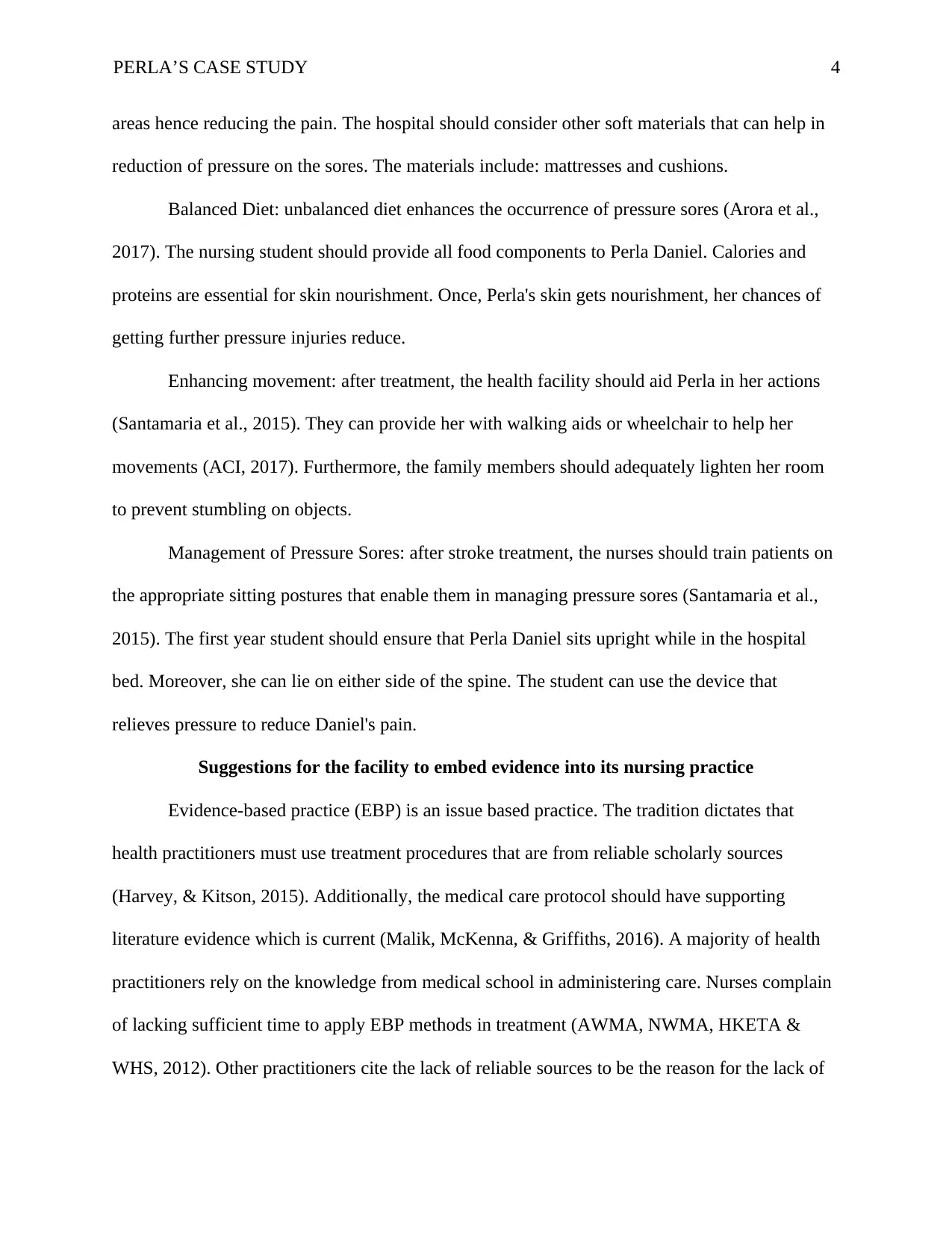
PERLA’S CASE STUDY 4
areas hence reducing the pain. The hospital should consider other soft materials that can help in
reduction of pressure on the sores. The materials include: mattresses and cushions.
Balanced Diet: unbalanced diet enhances the occurrence of pressure sores (Arora et al.,
2017). The nursing student should provide all food components to Perla Daniel. Calories and
proteins are essential for skin nourishment. Once, Perla's skin gets nourishment, her chances of
getting further pressure injuries reduce.
Enhancing movement: after treatment, the health facility should aid Perla in her actions
(Santamaria et al., 2015). They can provide her with walking aids or wheelchair to help her
movements (ACI, 2017). Furthermore, the family members should adequately lighten her room
to prevent stumbling on objects.
Management of Pressure Sores: after stroke treatment, the nurses should train patients on
the appropriate sitting postures that enable them in managing pressure sores (Santamaria et al.,
2015). The first year student should ensure that Perla Daniel sits upright while in the hospital
bed. Moreover, she can lie on either side of the spine. The student can use the device that
relieves pressure to reduce Daniel's pain.
Suggestions for the facility to embed evidence into its nursing practice
Evidence-based practice (EBP) is an issue based practice. The tradition dictates that
health practitioners must use treatment procedures that are from reliable scholarly sources
(Harvey, & Kitson, 2015). Additionally, the medical care protocol should have supporting
literature evidence which is current (Malik, McKenna, & Griffiths, 2016). A majority of health
practitioners rely on the knowledge from medical school in administering care. Nurses complain
of lacking sufficient time to apply EBP methods in treatment (AWMA, NWMA, HKETA &
WHS, 2012). Other practitioners cite the lack of reliable sources to be the reason for the lack of
areas hence reducing the pain. The hospital should consider other soft materials that can help in
reduction of pressure on the sores. The materials include: mattresses and cushions.
Balanced Diet: unbalanced diet enhances the occurrence of pressure sores (Arora et al.,
2017). The nursing student should provide all food components to Perla Daniel. Calories and
proteins are essential for skin nourishment. Once, Perla's skin gets nourishment, her chances of
getting further pressure injuries reduce.
Enhancing movement: after treatment, the health facility should aid Perla in her actions
(Santamaria et al., 2015). They can provide her with walking aids or wheelchair to help her
movements (ACI, 2017). Furthermore, the family members should adequately lighten her room
to prevent stumbling on objects.
Management of Pressure Sores: after stroke treatment, the nurses should train patients on
the appropriate sitting postures that enable them in managing pressure sores (Santamaria et al.,
2015). The first year student should ensure that Perla Daniel sits upright while in the hospital
bed. Moreover, she can lie on either side of the spine. The student can use the device that
relieves pressure to reduce Daniel's pain.
Suggestions for the facility to embed evidence into its nursing practice
Evidence-based practice (EBP) is an issue based practice. The tradition dictates that
health practitioners must use treatment procedures that are from reliable scholarly sources
(Harvey, & Kitson, 2015). Additionally, the medical care protocol should have supporting
literature evidence which is current (Malik, McKenna, & Griffiths, 2016). A majority of health
practitioners rely on the knowledge from medical school in administering care. Nurses complain
of lacking sufficient time to apply EBP methods in treatment (AWMA, NWMA, HKETA &
WHS, 2012). Other practitioners cite the lack of reliable sources to be the reason for the lack of
Paraphrase This Document
Need a fresh take? Get an instant paraphrase of this document with our AI Paraphraser
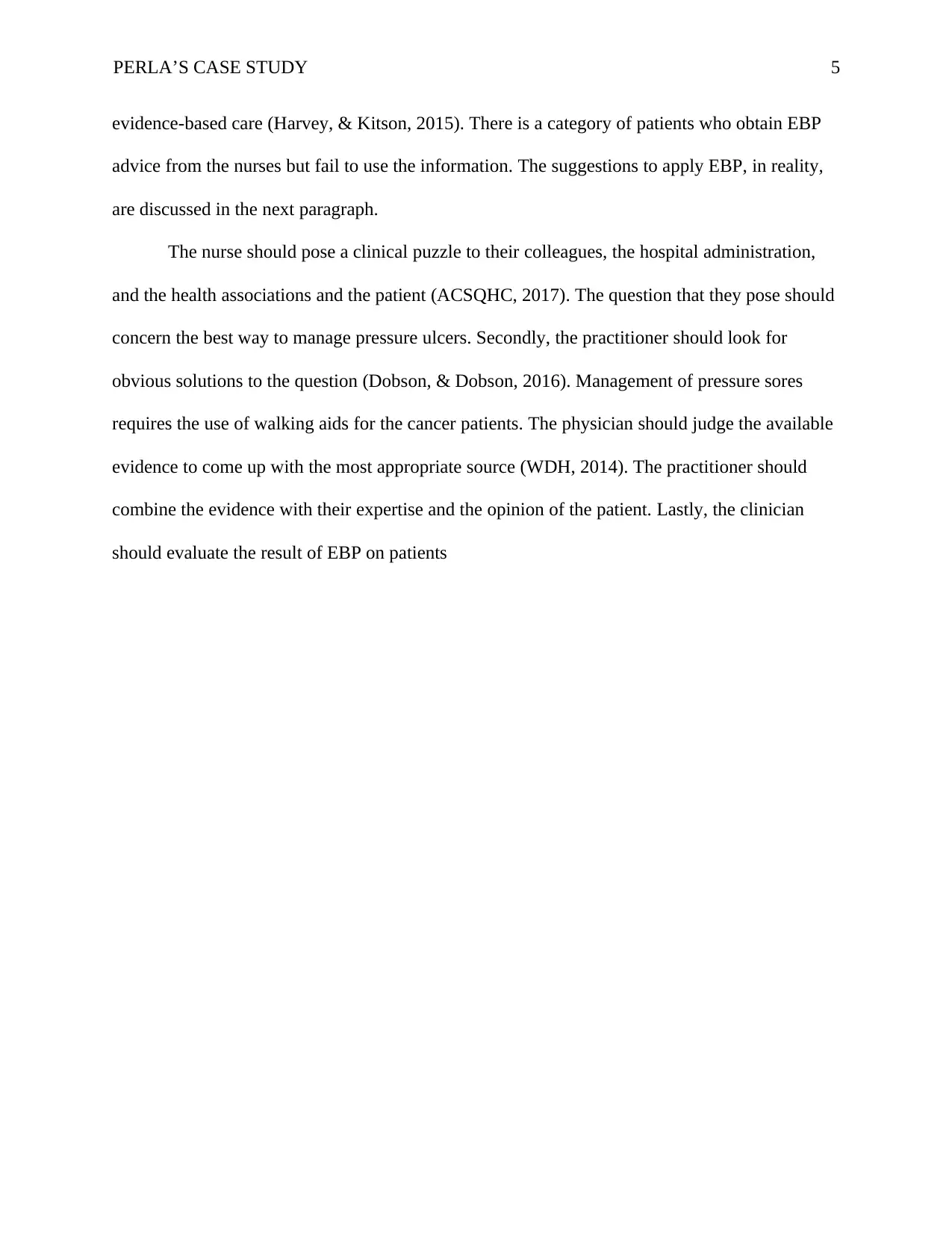
PERLA’S CASE STUDY 5
evidence-based care (Harvey, & Kitson, 2015). There is a category of patients who obtain EBP
advice from the nurses but fail to use the information. The suggestions to apply EBP, in reality,
are discussed in the next paragraph.
The nurse should pose a clinical puzzle to their colleagues, the hospital administration,
and the health associations and the patient (ACSQHC, 2017). The question that they pose should
concern the best way to manage pressure ulcers. Secondly, the practitioner should look for
obvious solutions to the question (Dobson, & Dobson, 2016). Management of pressure sores
requires the use of walking aids for the cancer patients. The physician should judge the available
evidence to come up with the most appropriate source (WDH, 2014). The practitioner should
combine the evidence with their expertise and the opinion of the patient. Lastly, the clinician
should evaluate the result of EBP on patients
evidence-based care (Harvey, & Kitson, 2015). There is a category of patients who obtain EBP
advice from the nurses but fail to use the information. The suggestions to apply EBP, in reality,
are discussed in the next paragraph.
The nurse should pose a clinical puzzle to their colleagues, the hospital administration,
and the health associations and the patient (ACSQHC, 2017). The question that they pose should
concern the best way to manage pressure ulcers. Secondly, the practitioner should look for
obvious solutions to the question (Dobson, & Dobson, 2016). Management of pressure sores
requires the use of walking aids for the cancer patients. The physician should judge the available
evidence to come up with the most appropriate source (WDH, 2014). The practitioner should
combine the evidence with their expertise and the opinion of the patient. Lastly, the clinician
should evaluate the result of EBP on patients
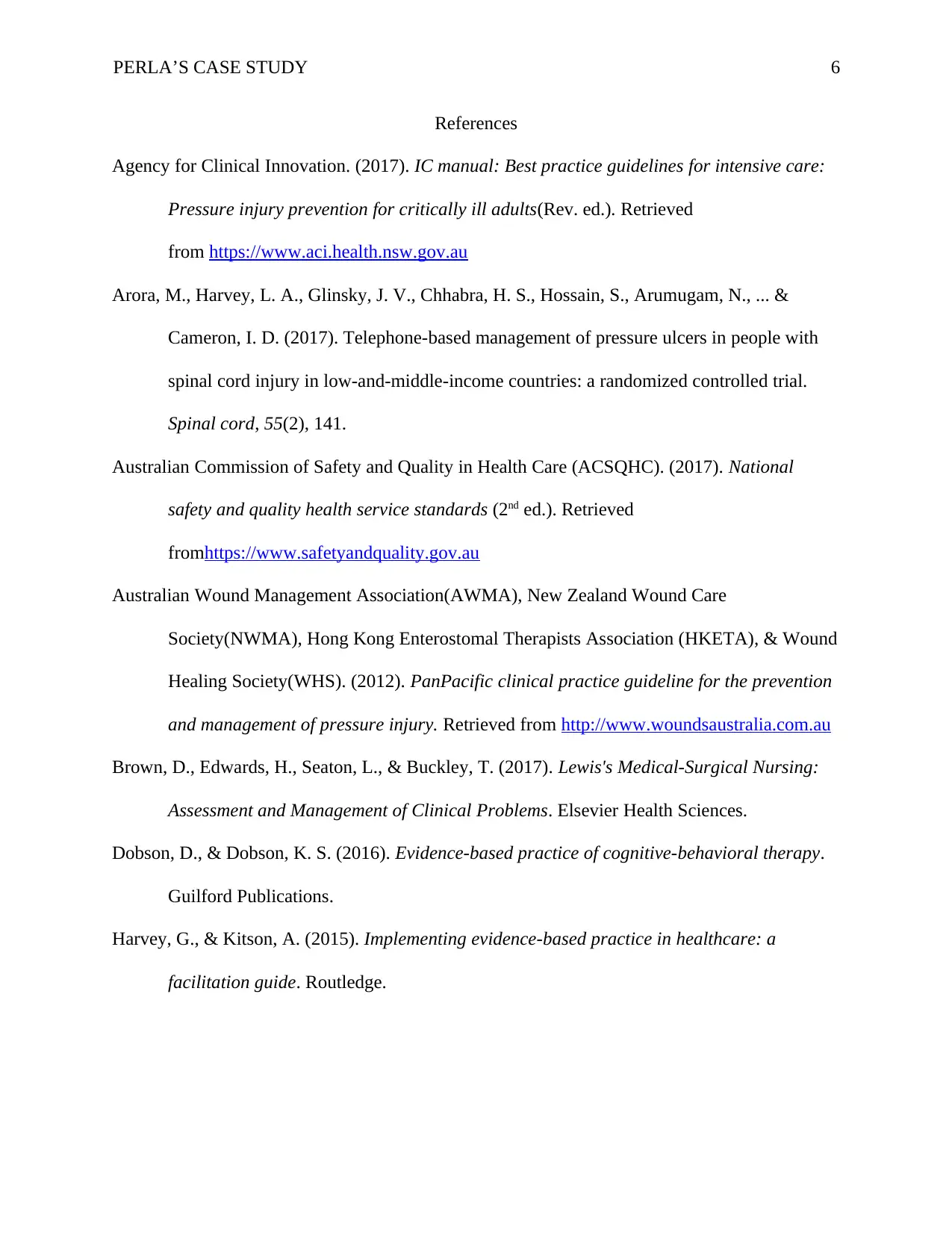
PERLA’S CASE STUDY 6
References
Agency for Clinical Innovation. (2017). IC manual: Best practice guidelines for intensive care:
Pressure injury prevention for critically ill adults(Rev. ed.). Retrieved
from https://www.aci.health.nsw.gov.au
Arora, M., Harvey, L. A., Glinsky, J. V., Chhabra, H. S., Hossain, S., Arumugam, N., ... &
Cameron, I. D. (2017). Telephone-based management of pressure ulcers in people with
spinal cord injury in low-and-middle-income countries: a randomized controlled trial.
Spinal cord, 55(2), 141.
Australian Commission of Safety and Quality in Health Care (ACSQHC). (2017). National
safety and quality health service standards (2nd ed.). Retrieved
fromhttps://www.safetyandquality.gov.au
Australian Wound Management Association(AWMA), New Zealand Wound Care
Society(NWMA), Hong Kong Enterostomal Therapists Association (HKETA), & Wound
Healing Society(WHS). (2012). PanPacific clinical practice guideline for the prevention
and management of pressure injury. Retrieved from http://www.woundsaustralia.com.au
Brown, D., Edwards, H., Seaton, L., & Buckley, T. (2017). Lewis's Medical-Surgical Nursing:
Assessment and Management of Clinical Problems. Elsevier Health Sciences.
Dobson, D., & Dobson, K. S. (2016). Evidence-based practice of cognitive-behavioral therapy.
Guilford Publications.
Harvey, G., & Kitson, A. (2015). Implementing evidence-based practice in healthcare: a
facilitation guide. Routledge.
References
Agency for Clinical Innovation. (2017). IC manual: Best practice guidelines for intensive care:
Pressure injury prevention for critically ill adults(Rev. ed.). Retrieved
from https://www.aci.health.nsw.gov.au
Arora, M., Harvey, L. A., Glinsky, J. V., Chhabra, H. S., Hossain, S., Arumugam, N., ... &
Cameron, I. D. (2017). Telephone-based management of pressure ulcers in people with
spinal cord injury in low-and-middle-income countries: a randomized controlled trial.
Spinal cord, 55(2), 141.
Australian Commission of Safety and Quality in Health Care (ACSQHC). (2017). National
safety and quality health service standards (2nd ed.). Retrieved
fromhttps://www.safetyandquality.gov.au
Australian Wound Management Association(AWMA), New Zealand Wound Care
Society(NWMA), Hong Kong Enterostomal Therapists Association (HKETA), & Wound
Healing Society(WHS). (2012). PanPacific clinical practice guideline for the prevention
and management of pressure injury. Retrieved from http://www.woundsaustralia.com.au
Brown, D., Edwards, H., Seaton, L., & Buckley, T. (2017). Lewis's Medical-Surgical Nursing:
Assessment and Management of Clinical Problems. Elsevier Health Sciences.
Dobson, D., & Dobson, K. S. (2016). Evidence-based practice of cognitive-behavioral therapy.
Guilford Publications.
Harvey, G., & Kitson, A. (2015). Implementing evidence-based practice in healthcare: a
facilitation guide. Routledge.
⊘ This is a preview!⊘
Do you want full access?
Subscribe today to unlock all pages.

Trusted by 1+ million students worldwide
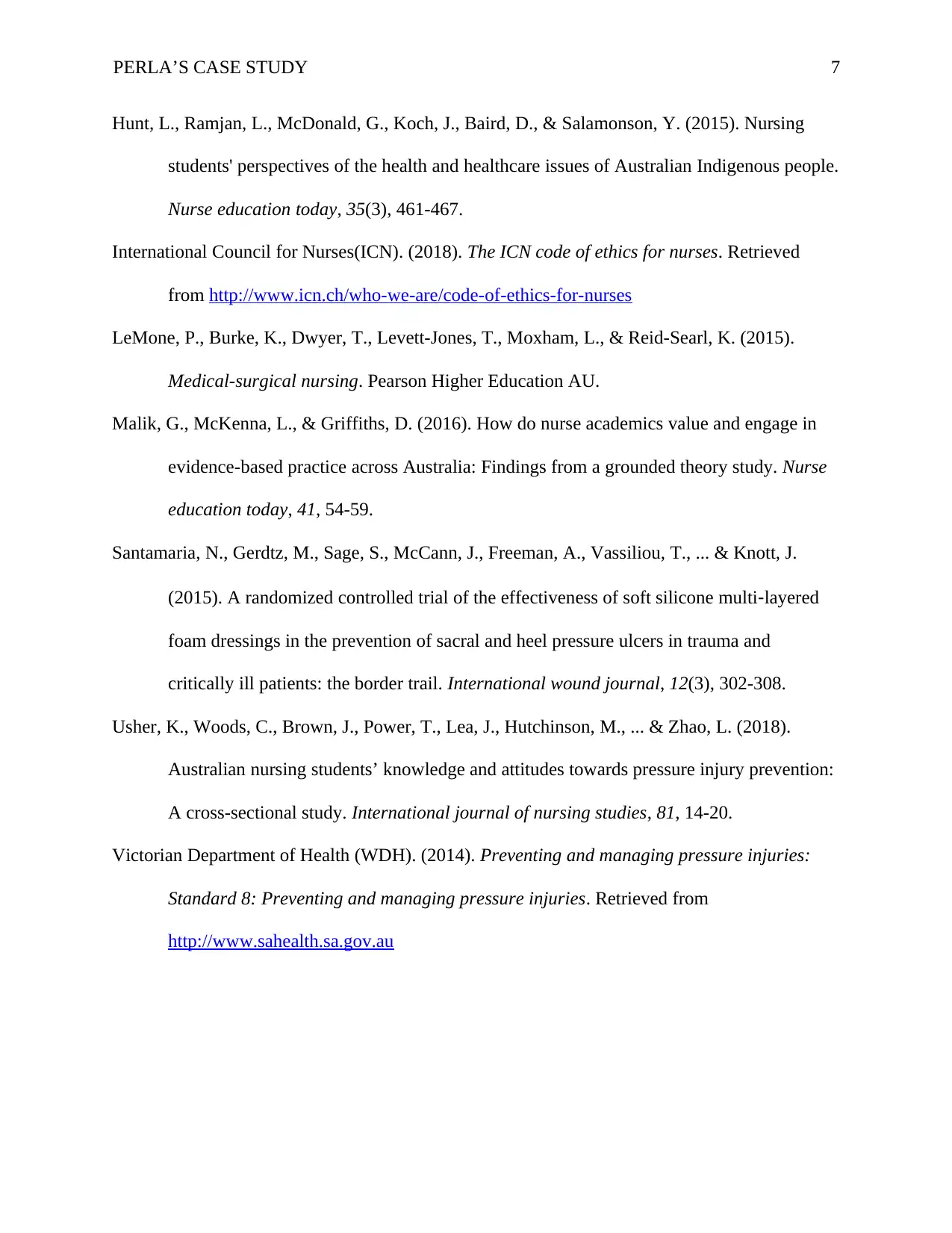
PERLA’S CASE STUDY 7
Hunt, L., Ramjan, L., McDonald, G., Koch, J., Baird, D., & Salamonson, Y. (2015). Nursing
students' perspectives of the health and healthcare issues of Australian Indigenous people.
Nurse education today, 35(3), 461-467.
International Council for Nurses(ICN). (2018). The ICN code of ethics for nurses. Retrieved
from http://www.icn.ch/who-we-are/code-of-ethics-for-nurses
LeMone, P., Burke, K., Dwyer, T., Levett-Jones, T., Moxham, L., & Reid-Searl, K. (2015).
Medical-surgical nursing. Pearson Higher Education AU.
Malik, G., McKenna, L., & Griffiths, D. (2016). How do nurse academics value and engage in
evidence-based practice across Australia: Findings from a grounded theory study. Nurse
education today, 41, 54-59.
Santamaria, N., Gerdtz, M., Sage, S., McCann, J., Freeman, A., Vassiliou, T., ... & Knott, J.
(2015). A randomized controlled trial of the effectiveness of soft silicone multi‐layered
foam dressings in the prevention of sacral and heel pressure ulcers in trauma and
critically ill patients: the border trail. International wound journal, 12(3), 302-308.
Usher, K., Woods, C., Brown, J., Power, T., Lea, J., Hutchinson, M., ... & Zhao, L. (2018).
Australian nursing students’ knowledge and attitudes towards pressure injury prevention:
A cross-sectional study. International journal of nursing studies, 81, 14-20.
Victorian Department of Health (WDH). (2014). Preventing and managing pressure injuries:
Standard 8: Preventing and managing pressure injuries. Retrieved from
http://www.sahealth.sa.gov.au
Hunt, L., Ramjan, L., McDonald, G., Koch, J., Baird, D., & Salamonson, Y. (2015). Nursing
students' perspectives of the health and healthcare issues of Australian Indigenous people.
Nurse education today, 35(3), 461-467.
International Council for Nurses(ICN). (2018). The ICN code of ethics for nurses. Retrieved
from http://www.icn.ch/who-we-are/code-of-ethics-for-nurses
LeMone, P., Burke, K., Dwyer, T., Levett-Jones, T., Moxham, L., & Reid-Searl, K. (2015).
Medical-surgical nursing. Pearson Higher Education AU.
Malik, G., McKenna, L., & Griffiths, D. (2016). How do nurse academics value and engage in
evidence-based practice across Australia: Findings from a grounded theory study. Nurse
education today, 41, 54-59.
Santamaria, N., Gerdtz, M., Sage, S., McCann, J., Freeman, A., Vassiliou, T., ... & Knott, J.
(2015). A randomized controlled trial of the effectiveness of soft silicone multi‐layered
foam dressings in the prevention of sacral and heel pressure ulcers in trauma and
critically ill patients: the border trail. International wound journal, 12(3), 302-308.
Usher, K., Woods, C., Brown, J., Power, T., Lea, J., Hutchinson, M., ... & Zhao, L. (2018).
Australian nursing students’ knowledge and attitudes towards pressure injury prevention:
A cross-sectional study. International journal of nursing studies, 81, 14-20.
Victorian Department of Health (WDH). (2014). Preventing and managing pressure injuries:
Standard 8: Preventing and managing pressure injuries. Retrieved from
http://www.sahealth.sa.gov.au
1 out of 7
Related Documents
Your All-in-One AI-Powered Toolkit for Academic Success.
+13062052269
info@desklib.com
Available 24*7 on WhatsApp / Email
![[object Object]](/_next/static/media/star-bottom.7253800d.svg)
Unlock your academic potential
Copyright © 2020–2025 A2Z Services. All Rights Reserved. Developed and managed by ZUCOL.



